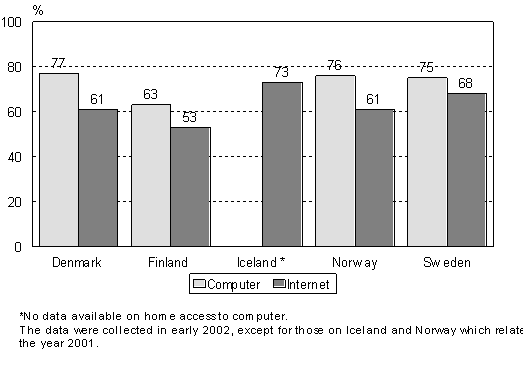18 December 2002
Inquiries: Mr Ari Leppälahti +358 9 1734 3237
Director in charge: Ms Kaija Hovi
Information and communication technology widely used in the Nordic Countries
In 2002, approximately 60 per cent of the population aged 16 to 74 in the Nordic Countries were able access the Internet from home. Home access was the most widespread in Iceland, where just over 70 per cent of the population had one, with Sweden coming next with its corresponding figure of close on 70 per cent. The frequency of home access to the Internet was the lowest among the Nordic Countries in Finland at 53 per cent of the population. These data are derived from the publication Nordic Information Society Statistics 2002, issued jointly by the Nordic Council of Ministers and the National Statistical Institutes of the Nordic Countries.
In Finland, Sweden and Denmark, 65 to 70 per cent of the population aged 16 to 74 used the computer at least once a week in the early part of 2002. The Internet was used most actively in Iceland, where 70 per cent of the population in this age group accessed it weekly. The next most active country was Sweden with its 63 per cent share of weekly Internet users. Internet use was the least widespread in Denmark and Finland where the corresponding shares of the population were 56 and 52 per cent, respectively.
Access to computer and the Internet at home in the
Nordic Countries,
percentage of population aged 16 to 74

There are no essential differences between men and women in the use of information and communication technology, even though men are slightly more active users of the Internet. On the other hand, those with higher education make more use of information technology. The most distinguishing variable in this respect, however, is age, for a clear majority of those aged 60 to 74 do not use the computer or the Internet. All in all, the Nordic countries are among the forerunners in the world in the utilisation of information and communication technology.
Over 90 per cent of the enterprises employing more than 10 persons in the Nordic Countries use the Internet. Depending on the country, between 55 and 78 per cent of these enterprises had their own homepages and 34 to 65 per cent had broadband connections. Enterprises in Norway made somewhat less use of information technology than those in the other Nordic Countries. Unlike the use of information technology on the whole, Internet sales are not yet very widely practised by Nordic enterprises. Only 10 or so per cent of the enterprises with more than ten employees generated at least one per cent of their turnover via the Internet. An exception to this was Iceland where the share of the enterprises meeting these criteria was 16 per cent.
The information sector has the greatest importance in Finland and Sweden
In the Nordic Countries, the information sector's production of goods and services provided employment to approximately 510,000 persons in the year 2000, which is close on nine per cent of total employment in the private sector. Especially in Finland the IT manufacturing sector is of major economic importance, as it accounted for almost one-quarter of the country's total manufacturing turnover in 2000. However, the strong growth rate of the latter half of the 1990s slowed down in 2000, especially in goods production.
The slowdown of the information sector becomes even clearer from 2001 data on the foreign trade in IT products. In Sweden, the proportion of these products of total exports fell from 20 per cent to 13 per cent and in Finland from 25 per cent to 22 per cent. Contrastingly, no similar changes were evidenced in the other Nordic Countries where exports of IT products accounted for a distinctly smaller proportion of total exports. In Denmark the proportion was 8 to10 per cent, in Norway 3 to 4 per cent and in Iceland only around 0.1 per cent.
Source: Information Society Statistics 2002.
Nordic Council of Ministers, Statistics Denmark, Statistics
Finland, Statistics Iceland, Statistics Norway, Statistics
Sweden
The publication is available in pdf format at: http://stat.fi/tk/yr/tietoyhteiskunta/index_en.html
